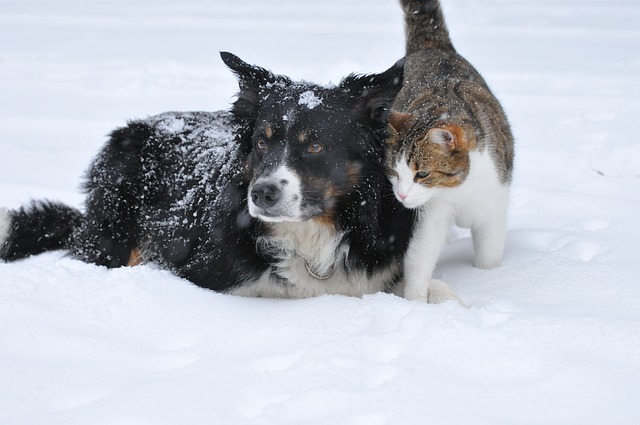As the weather gets colder, it’s time to think about how to keep our pets happy and healthy over the winter. While younger animals often enjoy the cold, crisp air, and even the frost and (if we’re really lucky!) snow; the season can be hard for more mature pets. In this blog we’ll have a look at what we can do to keep them comfortable!
1) Adjust for Arthritis
Cold, damp winter weather can often make stiff joints flare up, causing stiffness, reluctance to exercise, pain and sometimes hot and swollen joints too. Although we tend to think of arthritis as a disease of dogs, it’s equally common in cats, too – we just don’t recognise it as easily. In fact, any animal can, and often will, develop arthritis in old age, so this advice applies to creaky cats and rickety rabbits too!
The most important factor in managing arthritis is to make life as easy as possible for the pet. If, for example, your dog struggles to jump into the car for a walk, try a dog ramp. If your cat is struggling to get into their litter tray, buy one with shallower sides (this is a surprisingly common cause of “incontinence” in older cats!). If an elderly bunny isn’t able to rear up to reach his drinker easily, lower it by a few inches. These aren’t complicated or difficult, but can make the world of difference!
It’s also important to keep arthritic pets mobile – once they “seize up” it can be very hard for them to get going again, and insufficient joint motion can worsen the underlying condition by restricting the flow of joint fluid. However, the exercise does have to be little and often, so as not to overuse those sore joints. So, instead of an hour-long walk for your dog, try and get three or four fifteen minute walks in; instead of a whole night out hunting for your cat, think about toys they can play with in the house for shorter periods. Stiff and arthritic animals can also benefit from physiotherapy and hydrotherapy – give us a call and our vets can advise you on physio techniques, or refer you to a qualified physiotherapist or for hydrotherapy.
Painkillers are often needed for the first time in winter as, while a pet may cope in the warmer months, the pain becomes unmanageable in the cold. So make sure you talk to us about the options before there’s a problem!
2) Warm Winter Wear
It’s cold out, and older pets feel the cold more acutely than when they were younger. For short-coated dogs (e.g. Greyhounds and Chihuahuas), a woolly jumper is a must in cold weather! While cats tend not to appreciate this (maybe as a result of a better developed fashion sense?!), it’s important to make sure they’ve always got access to the house to warm up, so make sure the cat-flap works and isn’t frozen shut, and that they know how to use it.
3) Sleeping Snugly
When an animal’s ready to go to sleep, their body temperature drops noticeably. However, if it’s too cold, it will prevent them from sleeping well, especially if they’re sensitive to colder weather. Arthritic joints often stiffen overnight in the cold too, so make sure there’s a warm, dry and draught-free bed for every member of your household, whatever species! Dogs generally adopt a bed as theirs, but cats are more likely to pick and mix – so make sure if you have several cats that there’s a cozy bed for everyone and if possible a spare one too.
Rabbits and small rodents like gerbils and hamsters can feel the cold really badly too, so make sure they have extra bedding in the winter, and if possible bring houses and hutches indoors out of the cold – even being in a garage or shed is better than being exposed to the frost!
4) Medical Maintenance
Pets with health conditions have extra needs – for example, a pet with kidney failure needs a constant supply of fresh water, and if it freezes even for a few hours, the results can be disastrous. So before the cold really starts to bite, make an appointment for a “Winter Health Check” with one of our vets or nurses, so you can keep them comfortable all through till spring!

